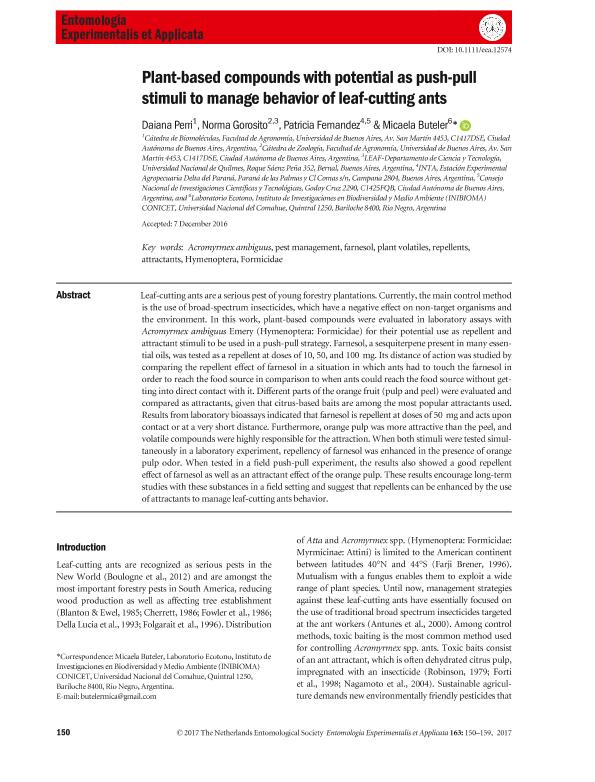Artículo
Plant-based compounds with potential as push-pull stimuli to manage behavior of leaf-cutting ants
Fecha de publicación:
05/2017
Editorial:
Wiley Blackwell Publishing, Inc
Revista:
Entomologia Experimentalis et Applicata
ISSN:
0013-8703
Idioma:
Inglés
Tipo de recurso:
Artículo publicado
Clasificación temática:
Resumen
Leaf-cutting ants are a serious pest of young forestry plantations. Currently, the main control method is the use of broad-spectrum insecticides, which have a negative effect on non-target organisms and the environment. In this work, plant-based compounds were evaluated in laboratory assays with Acromyrmex ambiguus Emery (Hymenoptera: Formicidae) for their potential use as repellent and attractant stimuli to be used in a push-pull strategy. Farnesol, a sesquiterpene present in many essential oils, was tested as a repellent at doses of 10, 50, and 100 mg. Its distance of action was studied by comparing the repellent effect of farnesol in a situation in which ants had to touch the farnesol in order to reach the food source in comparison to when ants could reach the food source without getting into direct contact with it. Different parts of the orange fruit (pulp and peel) were evaluated and compared as attractants, given that citrus-based baits are among the most popular attractants used. Results from laboratory bioassays indicated that farnesol is repellent at doses of 50 mg and acts upon contact or at a very short distance. Furthermore, orange pulp was more attractive than the peel, and volatile compounds were highly responsible for the attraction. When both stimuli were tested simultaneously in a laboratory experiment, repellency of farnesol was enhanced in the presence of orange pulp odor. When tested in a field push-pull experiment, the results also showed a good repellent effect of farnesol as well as an attractant effect of the orange pulp. These results encourage long-term studies with these substances in a field setting and suggest that repellents can be enhanced by the use of attractants to manage leaf-cutting ants behavior.
Archivos asociados
Licencia
Identificadores
Colecciones
Articulos(INIBIOMA)
Articulos de INST. DE INVEST.EN BIODIVERSIDAD Y MEDIOAMBIENTE
Articulos de INST. DE INVEST.EN BIODIVERSIDAD Y MEDIOAMBIENTE
Articulos(SEDE CENTRAL)
Articulos de SEDE CENTRAL
Articulos de SEDE CENTRAL
Citación
Perri, Daiana Vanesa; Gorosito, Norma Beatriz; Fernandez, Patricia Carina; Buteler, Micaela; Plant-based compounds with potential as push-pull stimuli to manage behavior of leaf-cutting ants; Wiley Blackwell Publishing, Inc; Entomologia Experimentalis et Applicata; 163; 2; 5-2017; 150-159
Compartir
Altmétricas




